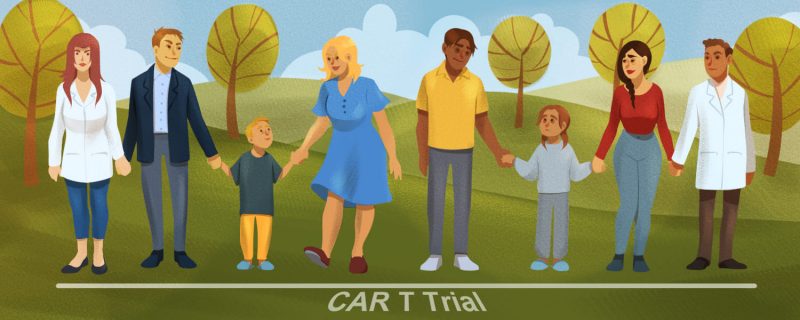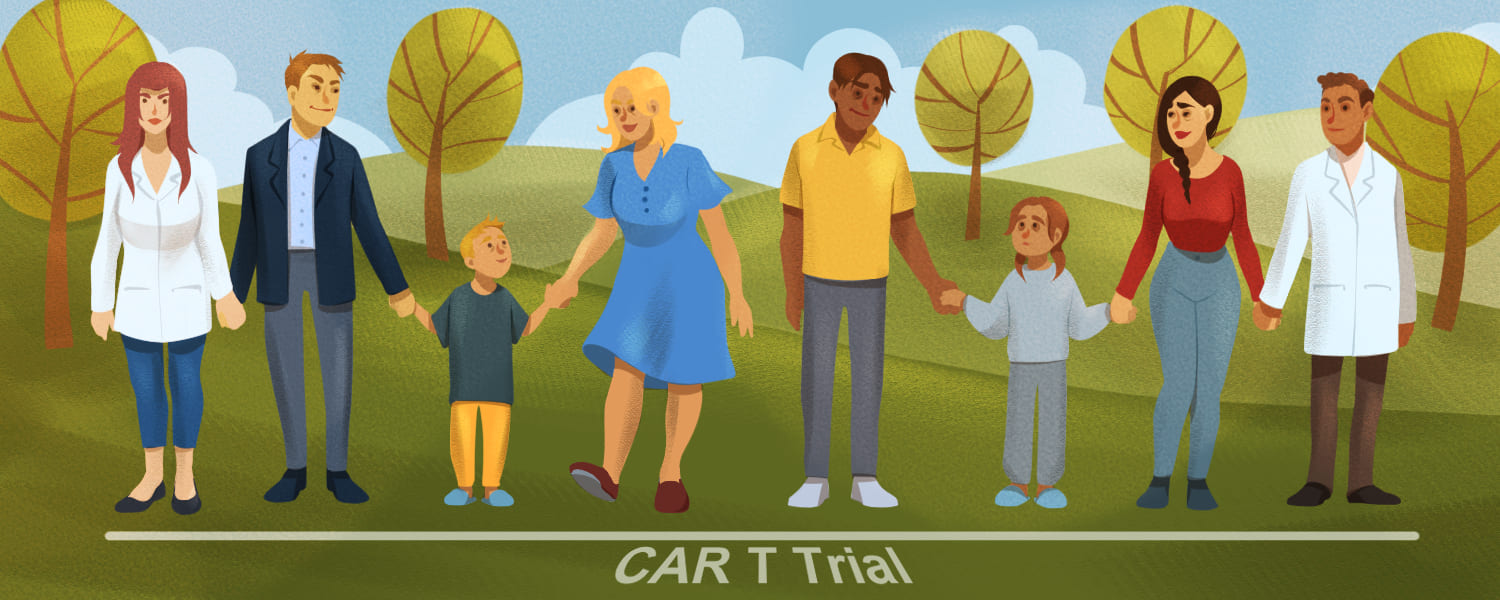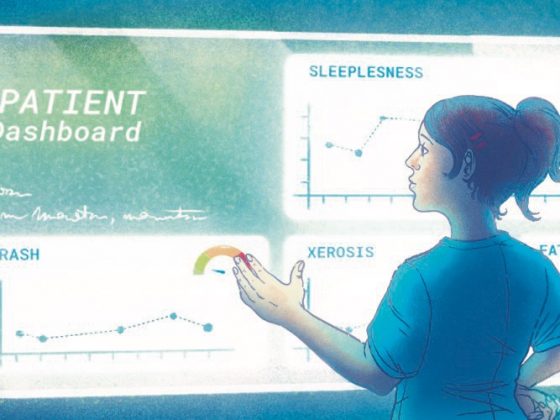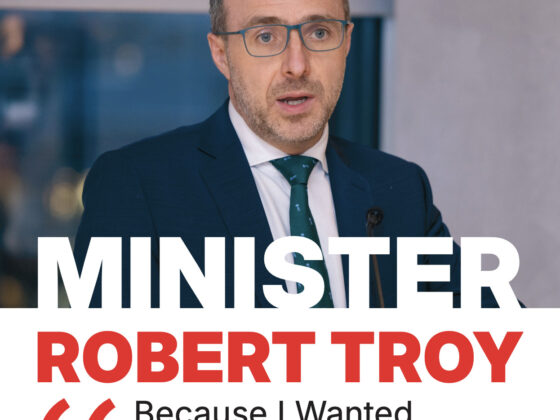Chimeric antigen receptor (CAR) T cells, genetically engineered immune cells targeted to attack cancers, are one of the most exciting breakthrough cancer treatments in oncology today. After decades of incremental development, its clinical efficacy was shown in 2010, with the successful treatment of a handful of adult patients with chronic lymphocytic leukemia.
CAR T cells are created by extracting T cells from the patient and genetically engineering them to attack a particular target, in this case the CD19 protein present on B cells. This was a revolutionary treatment, unlike any that had preceded it. In 2012, with clinical experience of its use in adults still very limited both in numbers and in duration of follow-up, the therapy was tested for the first time in a child. This was the well-publicised case of Emily Whitehead, an eight-year-old girl who had run out of treatment options for her relapsed acute lymphoblastic leukaemia (ALL). Her parents agreed, as a final throw of the dice, to try the experimental approach at the Children’s Hospital of Philadelphia.
Children and childhood cancers differ in many ways to adults, and Emily’s treating physicians didn’t know what to expect, as Stephan Grupp, Chief of the Cellular Therapy and Transplant Section and Director of the Cell and Gene Therapy Laboratory at the Children’s Hospital of Philadelphia, remembers. “When we first gave CAR T cells to a child with ALL in April 2012, we truly had no idea what was going to happen.”
Happily, the therapy worked better than anyone could have hoped for. In 2022 Emily, who by then had turned 18, celebrated 10 years cancer-free and her foundation continues to advocate for more research into CAR T cells.
“Sure didn’t expect that,” says Grupp, who went on to trial the treatment in other children. “But, there were many things that we didn’t expect: for it to work as well as it did, as long as it did, we didn’t expect 40–50% of patients to not need any further treatment, including transplant.”
In 2017 CAR T-cell therapy was approved by the US FDA for use in some children and young adults with leukaemia. For those who can access it, this therapy now offers a potential lifeline for the small minority of children – around one in ten in high-income countries – whose disease is not curable using the standard of care treatment.
Six years on from that approval, the paediatric oncology community has been gaining valuable experience using the therapy, sometimes as a last-hope curative option as with Emily, sometimes in preparation for a hopefully curative bone marrow transplant.
Growing confidence in using CAR T cells in advanced disease is now prompting questions about what they might achieve in a first-line setting
Growing confidence in their understanding of the therapy, and how best to use it in advanced disease, is now prompting questions about what CAR T-cell therapy might achieve if used in a first-line setting, in newly diagnosed patients.
At a practical level, challenges include the high cost, the lack of capacity to handle CAR T therapy outside of a very limited number of centres of excellence, and also the length of time it takes to engineer the cells. Children diagnosed with leukaemia tend to need urgent treatment and it currently takes around two weeks to prepare CAR T cells.
At a clinical level, the hope would be to spare children many of the gruelling side effects of current treatments, and the associated chronic health conditions that impact on the quality of their adult lives. The fear would be diving into the unknown – rejecting a tried and tested treatment that delivers a cure for nine in ten patients in favour of a newer therapy whose efficacy is still uncertain. The only way to find out would be to try.
So the question currently preoccupying many in the paediatric cancer community is: how much more certainty about the potential risks and benefits of CAR T-therapy do we need before we trial it as a first-line treatment, and how quickly can we get that?
Known knowns, and known unknowns
CAR T-cell therapy is not without its own side effects. Notable among them is cytokine release syndrome (CRS), a fairly common toxic effect caused by rapid expansion of CAR T cells and immune activation. This could have proved fatal to Emily Whitehead, had her doctors not worked at immense speed to try to understand why, shortly after the infusion, her blood pressure was plummeting and her temperature soaring, and work out what to do about it. “I remember we had to learn to treat that on the fly, literally on a Wednesday afternoon. What we now call CRS was life threatening for our first patient who ended up in intensive care. We didn’t expect the degree of toxicity that we saw,” says Grupp.
The solution found on that stressful Wednesday afternoon was to administer tocilizumab, a monoclonal antibody targeting the interleukin-6 receptor. This remains the cornerstone of treatment for cytokine release syndrome triggered by CAR T-cell therapy, with the big difference that treating physicians now know to look out for this dangerous side effect, and are able to manage it successfully in the majority of cases, though some patients may still require intensive care.
Many patients also experience neurological side effects from CAR T-cell therapy, something which has now been termed immune effector cell associated neurotoxicity (ICANS). Adults and children treated with CAR T cells can experience a range of different symptoms, both cognitive and motor-related. Although these are sometimes severe, they do seem to be reversible in most patients and researchers are still trying to fully explain why they occur in the first place.
The trouble is, CAR T cells simply haven’t been around for enough time and enough patients treated with them to comprehensively evaluate their side effects, particularly over the longer term. However, chemotherapy regimens certainly have, and contrasting what is known about CAR T cell side effects with the very well described gravity and duration of toxic effects from standard chemo treatments, it is easy to understand the widespread hope that CAR T-cell therapy might turn out to be more gentle on many children who undergo therapy.
How their curative potential matches up, however, is a different question.
A life-saver for kids who relapse
Allison Lyons is an internal medicine physician and mother to Colin, who was treated with chemotherapy for two years following a diagnosis with Philadelphia-chromosome-positive, high-risk ALL in 2018.
“We spent 120 days in the hospital due to chemotherapy and complications from chemotherapy. Colin had a lot of side effects – a sub-massive gastrointestinal bleed, pancreatitis, a pseudocyst that had to be drained twice, he had a C.diff infection and multiple hospitalisations for neutropenic fever,” she recalls.
Eight months after treatment ended, Colin experienced a relapse. His mother, along with Colin’s physicians, decided that the best option was to prepare Colin for a stem cell transplant. Instead of doing this with more chemotherapy, however, they opted for CAR T cells.
“We knew that we couldn’t just go through standard relapse therapy for him. I honestly think it would have killed him with how many side effects he had with the initial chemotherapy,” said Lyons.
“CAR T compared to chemotherapy was like night and day. With CAR T, he did not look sick, or like he had relapsed all that summer”
Colin was given CAR T cells made from his own immune cells to try to reduce the leukaemia burden in his system prior to a bone marrow transplant. He was given them as an outpatient and, other than fevers a week after receiving the therapy, he remained healthy.
“CAR T compared to chemotherapy was like night and day. With CAR T, he did not look sick, or like he had relapsed all that summer. When he had his bone marrow transplant, he was a healthy kid and I felt like that made the transplant so much easier,” said Lyons.
Hindsight is of course a wonderful thing. Neither Lyons nor Colin had any way of knowing in advance that his leukaemia would be in the small minority that is not cured by chemo. Nor could they have known that Colin would respond so well to CAR T cells. Lyons is keen to stress that her son was lucky to not have suffered any side-effects on CAR T-cell therapy and, despite their good experience, she acknowledges it isn’t perfect. While they were initially in hospital dealing with complications from his chemotherapy, she notes, a child on a CAR T cell trial passed away from complications linked to the therapy.
“I think we often wait too long to look at innovative therapies for paediatric cancer kids”
“I think it will always end up falling to the people who are the higher risk groups to try it out first. But I think we often wait too long to look at innovative therapies for paediatric cancer kids. There will be some kids who have complications from CAR T cells, including death, but we also have kids that die from regular chemotherapy too,” said Lyons.
We don’t know about what CAR T cells can do as a first-line therapy, because it has never been tried. Clinical experience over the past six years since it was approved for use in refractory or relapsed disease (i.e. the most aggressive cases) shows 40%–50% need no further treatment, but until it’s been trialled in newly diagnosed patients, we can’t know whether it could match or improve on the current 90% cure rate. Nor do we know for sure how undergoing CAR T cell therapy might affect a child’s chances of responding to alternative options should they relapse or fail to respond after receiving CAR T cells as first line treatment.
This would be a trial that pits a known successful cure against a therapy whose curative potential in first line is unknown
Weighing up all the available evidence to judge when it is right to trial an experimental treatment is an inherent part of medical ethics and medical progress. It’s the magnitude of what’s at stake here that makes it so hard in this instance.
This is not a typical trial aimed at buying more time for people with incurable cancer. Nor is it a trial aimed at boosting the chances of a cure, for instance by adding the drug before or after surgery. This would be a trial that pits a known successful cure against a therapy whose curative potential in first line is unknown. Entering your child, your patient, into such a trial would not be an easy decision to be make.
But as Jonathan Marron, paediatric oncologist and bioethicist at Boston Children’s Hospital, points out, just the prospect of being offered that option has to be good news. “Although navigating these questions will be challenging, the fact that these are decisions that we are going to be asking people to be making about treatment is fantastic. Because it speaks to the improvements that we’ve made.”
As he adds, it won’t be the first time families are asked about trialling alternative protocols that seek to reduce toxicities while hopefully not undermining the chance of a cure.
“Some of the larger leukaemia consortia are starting to peel away some of the more toxic pieces of chemotherapy in an attempt to decrease both long- and short-term toxicity. But this is a really difficult thing for clinicians and patients and their families to navigate, especially when conversations around treatments are often taking place on the same day that families are told their child has cancer.”
A leap of faith
Asking childhood cancer patients and caregivers to make difficult choices at incredibly stressful times is not new. As a childhood leukaemia patient diagnosed in 1994, I joined a trial aimed at reducing the damage done by irradiation to the spine and brain, which in those days was a routine part of treatment. The purpose of the radiation was to kill any leukaemia cells that might have migrated into the central nervous system, where the blood–brain barrier puts them out of reach of some chemotherapies, and they present a risk for relapse, which has a much poorer prognosis than primary leukaemia. But the radiotherapy was known to cause substantial acute and chronic side effects including cognitive impairment.
Brenda Gibson, now consultant paediatric oncologist at the Royal Hospital for Children, Glasgow, and honorary Professor in Paediatric Haematology at the University of Glasgow, was one of the investigators on that trial. “When I started practising, all children had their heads irradiated, it was standard treatment,” she says.
And sometimes children would have it more than once. “The relapse rate was higher then, so you would have some patients aged four or five who would get cranial radiation, relapse a few years later and get re-irradiated. It was extremely toxic, those children often required growth hormones because it affected the pituitary, many of them struggled at school.”
Trials conducted in the UK, US, and elsewhere from the late 1980s to the late 1990s offered patients like me, and our families, the chance to swap tried and tested radiation for high-dose injections of methotrexate, with the hope that it would be just as effective as radiation, but come with fewer side effects. Here too our chances of survival were at stake. If the methotrexate did not clear leukaemia from our central nervous systems as effectively as the radiotherapy, more children would relapse and more children would die.
Trials conducted from the late 1980s to mid 1990s offered patients like me, and our families, the chance to take a leap of faith
“You have to accept that there might be a risk and there is the potential to affect relapse. But there was this big stimulus with ourselves and other groups around the world to try to lose radiotherapy and reduce the side effects we were seeing on growth and IQ in children,” says Gibson.
Following that trial and other similar trials around the world, we now know that methotrexate is just as effective as radiation at preventing relapse, and this is now standard treatment.
Given the known neurocognitive effects of radiation for many survivors, it’s possible that I wouldn’t be writing this article now if that trial hadn’t been done when it was. But swapping out one treatment for another among a combination of several is not the same as sweeping the entire tried-and-tested cocktail aside for a completely different approach.
If a trial of CAR T cells as first line therapy was to be initiated, it would almost certainly come with an ‘abort switch’ whereby, if satisfactory results were not being achieved for any reason, patients would be pulled off the trial and put back onto regular therapy. But there is no way of telling whether the success rate of conventional therapy would be compromised after a failed attempt with CAR T cells.
This is just one of many considerations that parents, whose lives have just been upended by the news of their child’s leukaemia diagnosis, would need to bear in mind when weighing up the option of signing a consent form for a future trial that could see their child randomised to receiving CAR T cell therapy as an experimental first line treatment. Do they take the tried and tested chemotherapy regimen, with all its known short- and long-term toxic effects, or do they opt for the new therapy?
“Some families essentially want their doctor to tell them what they think is the right course and they are happy with that. But many prefer a more active role in the decision-making process, they want to know about the research and have informative conversations,” says Marron. “But we also have to realise that some families won’t want to try a trial, they want the standard of care, chemotherapy that they know works well. We have to recognise that the ‘right decision’ won’t be the same for all families.”
It is likely that, if a trial were available now, some patients and families, might want to opt to try CAR T cells as a first line therapy, after having weighed up the pros and cons based on the current state of evidence. Others will undoubtedly want to wait for further evidence, and some will never want their child to be one of the first to try a new therapy. The lifelong psychological burden of these decisions, and the ‘what ifs’ if the chosen treatment does not work for a child, are potentially devastating.
Everyone involved in CAR T cell development and testing owes it to patients and families to be able to edge as close as possible to being able to say that any risk of lower survival is negligible but the chance of lower toxicity and a healthier, longer lifespan is high compared to conventional treatment, before setting up a first-line trial. But it will eventually be up to patients, and in this case, caregivers like my parents in the mid 1990s, to make that final decision on whether or not to take that chance to help move the dial of progress not only for them, but the children and families diagnosed for decades afterwards.












